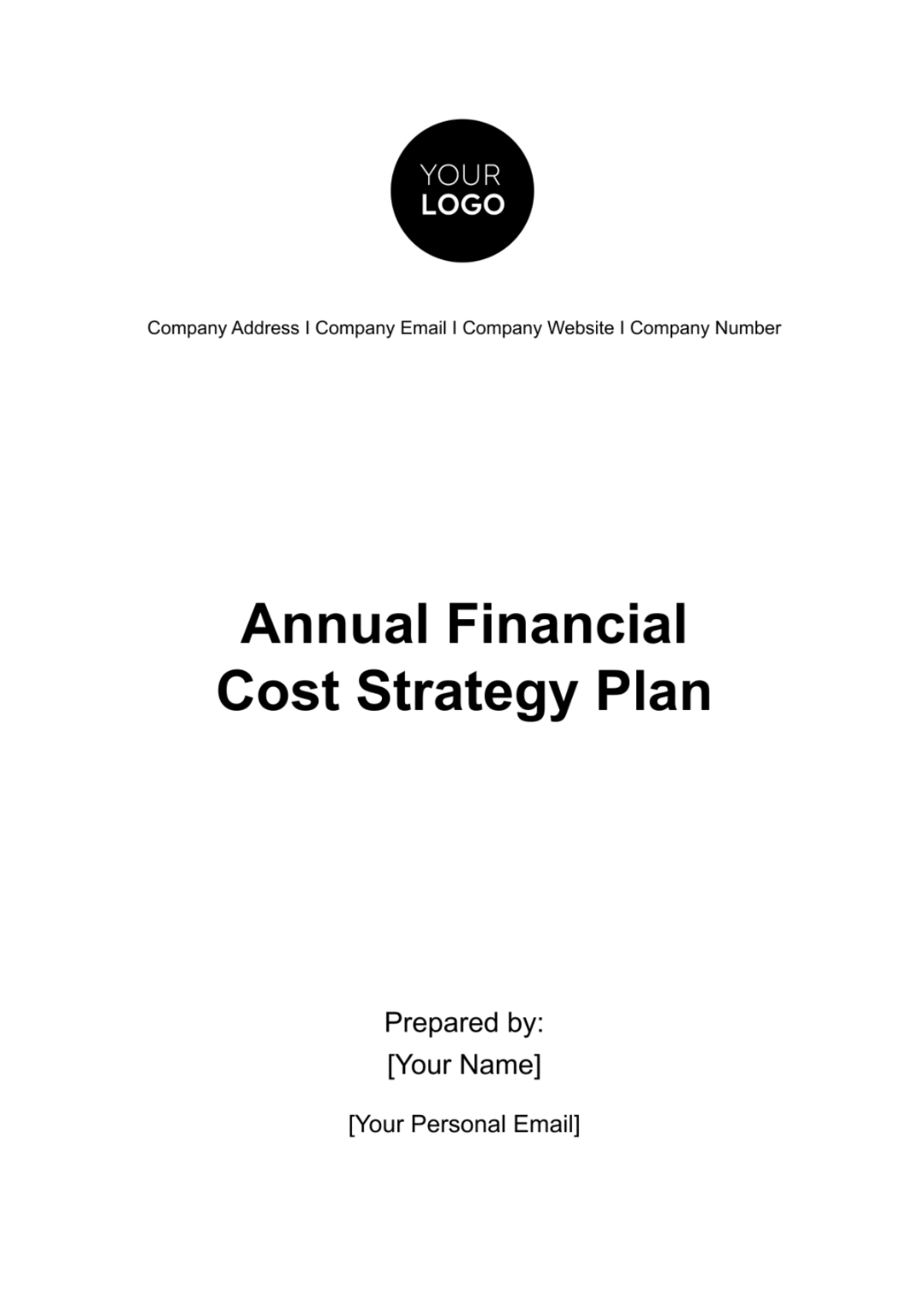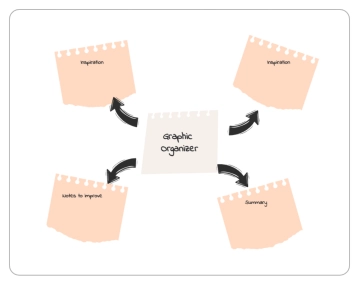Free Annual Financial Cost Strategy Plan

Executive Summary
As we embark on a pivotal year, our Annual Financial Cost Strategy Plan is tailored to position us for robust financial health and strategic growth. This plan encompasses comprehensive strategies spanning from aggressive financial goals to astute investment decisions, all designed to enhance profitability and ensure sustainable growth.
Financial Goals and Objectives: We have set ambitious yet achievable financial targets for this fiscal year. Key objectives include increasing our net profit margin from 15% to 18%, achieving a 10% revenue growth to reach $220 million, reducing operational costs by 5%, and maintaining a healthy debt-to-equity ratio under 0.5. These goals are pivotal in steering our organization towards heightened financial performance.
Revenue Forecast: Our revenue forecast is underpinned by a thorough analysis of market trends, historical data, and economic conditions. We project a 10% increase in revenue, driven largely by our expansion into new markets and the introduction of new product lines, alongside growth in digital services and eco-friendly products.
Expense Budget: Our expense budget is meticulously aligned with our revenue projections to ensure profitability. We are strategically increasing investments in areas like marketing and research & development, while simultaneously implementing cost-saving measures in operational expenses and debt repayment.
Cost Reduction Strategies: Our plan includes comprehensive strategies to reduce costs across various facets of the business. Key initiatives include process improvements, renegotiating supplier contracts, adopting energy-efficient technologies, and optimizing workforce efficiency. These measures are expected to significantly contribute to our bottom line.
Investment Plan: We are committed to investing strategically in technology and innovation, market expansion, employee development, sustainability projects, and product development. These investments are crucial for long-term competitiveness and are aligned with our overall financial strategy, aiming to drive revenue growth and enhance operational efficiency.
Cash Flow Management: Effective cash flow management is central to our plan. We are focusing on accurate cash flow forecasting, optimizing accounts receivable and inventory management, managing payables efficiently, and establishing contingency plans for cash shortfalls. Additionally, any surplus cash will be intelligently invested to generate returns, contributing further to our financial stability.
Financial Goals and Objectives
As we embark on a strategic journey to streamline our operations and enhance our financial stability, our primary focus for this fiscal year is to set achievable, yet ambitious, financial targets. Our financial goals and objectives are aligned with our long-term vision and are designed to position us for sustainable growth and profitability.
Goal | Objective | Strategy | Analysis |
Profit Margin Enhancement | Increase net profit margin from 15% to 18% | Increased operational efficiency, focus on higher-margin products and services | Aim for a net profit of $39.6 million on the same revenue, a $9.6 million increase |
Revenue Growth | Achieve a 10% year-on-year revenue growth, targeting $220 million | Expansion into new markets, enhancing online presence, launching new product lines | 10% increase requires an additional $20 million in revenue |
Cost Reduction Goals | Reduce operational costs by 5%, saving approximately $5 million | Process automation, renegotiating supplier contracts, reducing energy costs | Operational costs reduction expected to save $5 million |
Investment Returns | Achieve an average return of 8% on our investment portfolio | Diversifying investment portfolio, focusing on high-potential growth sectors | Increase from 6% to 8% returns would result in an additional $1 million |
Debt-to-Equity Ratio | Maintain a healthy debt-to-equity ratio under 0.5 | Prudent financial management, prioritizing equity financing over debt | Managing new debt to ensure it does not exceed $50 million to maintain ratio |
Revenue Forecast
In this section, we delve into our revenue forecast for the upcoming fiscal year, grounded in a comprehensive analysis of various influential factors. Our forecast is shaped by a careful examination of market trends, historical performance data, and prevailing economic forecasts, ensuring a well-informed and realistic projection of our expected income.
Market Trend Analysis: Current market analysis indicates a growing demand in our sector, particularly in areas of digital services and eco-friendly products. We anticipate capitalizing on these trends by introducing new product lines and enhancing our digital offerings, projected to contribute an additional 6% to our total revenue.
Historical Performance Review:
Category | Last Year's Revenue | Projected Growth |
Digital Services | $50 million (25%) | 15% (+$7.5 million) |
Eco-Friendly Products | $30 million (15%) | 20% (+$6 million) |
Other Products and Services | $120 million (60%) | 5% (+$6 million) |
Economic Forecasts: The economy is expected to grow moderately at a rate of 3% this year. This economic stability is conducive to business growth and customer spending, potentially leading to higher sales volumes in our primary markets.
New Initiatives and Product Launches: Introduction of two new product lines specifically tailored to emerging consumer needs. These new products are projected to generate an additional $8 million in revenue.
Pricing Strategy Adjustments: Slight price adjustments in line with market standards and increased value proposition. Expected to increase overall revenue by 2%, accounting for an additional $4 million.
Based on our analysis, the total projected revenue for the upcoming fiscal year is estimated to be $220 million, marking a substantial increase from the previous year's $200 million. This growth is primarily driven by our strategic focus on expanding digital services and eco-friendly products, coupled with the launch of new product lines and prudent pricing strategies.
Expense Budget
In this segment, we present a detailed projection of our anticipated expenses for the upcoming fiscal year. These projections are carefully categorized and aligned with our revenue forecast, ensuring a strategic approach to managing our costs while maintaining profitability.
Expense Category | Last Year | Projected | Change |
Operational Costs | $45 million | $42 million | -6.7% |
Marketing Expenses | $25 million | $27 million | +8% |
Salaries and Wages | $30 million | $31.5 million | +5% |
Research and Development (R&D) | $20 million | $22 million | +10% |
Administrative Expenses | $10 million | $10 million | No change |
Interest and Debt Repayment | $5 million | $4.5 million | -10% |
Miscellaneous Expenses | $5 million | $5.5 million | +10% |
Cost Reduction Strategies
In our ongoing effort to optimize financial performance, this section focuses on our dedicated strategies to significantly reduce costs across various aspects of our operations. These strategies encompass a range of initiatives, including process improvements, renegotiation of contracts, and the adoption of new technologies, all aimed at enhancing efficiency and reducing expenses.
Process Improvement Initiatives:
Objective: Streamline operational processes to reduce waste and increase efficiency.
Implementation: Adoption of lean management techniques and process automation tools.
Expected Savings: Estimated reduction in operational costs by 5%, amounting to approximately $2 million.
Renegotiation of Supplier Contracts:
Objective: Lower procurement costs by renegotiating terms with key suppliers.
Implementation: Engaging with suppliers to discuss bulk purchase discounts and more favorable payment terms.
Expected Savings: Anticipated decrease in supply chain expenses by 7%, saving around $1.4 million.
Adoption of Energy-Efficient Technologies:
Objective: Reduce energy costs by upgrading to more efficient technologies.
Implementation: Installation of energy-efficient lighting and HVAC systems in all facilities.
Expected Savings: Projected reduction in energy costs by 10%, totaling approximately $500,000.
Optimization of Marketing Spend:
Objective: Increase the efficiency of marketing expenditure.
Implementation: Shifting focus to more cost-effective digital marketing strategies and analytics-driven campaigns.
Expected Savings: Estimated savings of 8% in marketing expenses, equating to $2.16 million.
Investment Plan
This section delineates our strategy for investments in the upcoming fiscal year. It details the areas where we plan to allocate investment funds, the rationale behind these decisions, the expected returns, and how these investments align with our overarching financial strategy.
Investment Area | Rationale | Planned Investment | Expected Returns | Alignment with Financial Strategy |
Technology and Innovation | To stay ahead in a competitive market, investing in cutting-edge technology and innovation is crucial | $10 million in new software development and machine learning technologies | Increase operational efficiency by 15%, annual saving of $3 million | Supports cost reduction through improved efficiency and positions for long-term leadership |
Market Expansion Initiatives | Expanding into new markets is essential for revenue growth and diversification | $8 million in establishing presence in two new international markets | Additional annual revenue of $12 million from new markets within two years | Aligns with revenue growth objectives and reduces dependency on current markets |
Employee Training and Development | Investing in our workforce is vital for maintaining a high level of service and innovation | $2 million in advanced training programs and skill development workshops | Enhanced employee productivity and innovation, indirectly contributing to revenue | Enhances workforce efficiency and contributes to long-term profitability |
Sustainability Projects | Sustainability initiatives are crucial for corporate responsibility and can also lead to cost savings | $5 million in sustainable energy solutions and waste reduction programs | Reduction in energy costs by 20%, saving approximately $1 million annually | Supports cost reduction strategy while enhancing corporate image and responsibility |
Product Development and Innovation | Continuous product innovation is key to staying competitive and meeting customer needs | $4 million in developing new product lines and improving existing products | Increase in revenue by $10 million annually from new and improved products | Contributes to revenue growth and market leadership objectives |
Investment in Strategic Partnerships | Forming strategic partnerships can open new channels and markets, enhancing revenue potentials | $3 million in forming partnerships with key industry players | Access to new customer bases and markets, revenue increase of $5 million annually | Complements market expansion and revenue diversification goals |
Cash Flow Management
In this critical section, we address the management of our cash flow, a fundamental aspect of our overall financial health. Our strategy encompasses comprehensive analysis and proactive measures to effectively manage cash inflows and outflows, ensuring readiness to handle both shortfalls and surpluses.
Cash Flow Strategy | Objective | Implementation | Expected Outcome |
Cash Flow Forecasting | Accurately predict cash flow trends to avoid liquidity issues | Utilizing advanced forecasting tools to project cash inflows and outflows on a monthly basis | Early identification of potential cash shortfalls or surpluses, allowing timely decision-making |
Accounts Receivable Management | Enhance the collection of receivables to improve cash inflow | Implementing stricter credit policies and incentivizing early payments from customers | Reduction in average collection period from 45 to 30 days, improving cash liquidity |
Inventory Management Optimization | Reduce cash tied up in inventory without impacting supply chain efficiency | Adopting a just-in-time inventory system and negotiating better terms with suppliers | Decrease in inventory holding costs by 20%, freeing up cash for other uses |
Managing Payables | Efficiently manage payables to maintain good supplier relationships while optimizing cash outflow | Negotiating extended payment terms with suppliers and scheduling payments to align with cash flow forecasts | Improved cash flow management without compromising supplier trust and cooperation |
Contingency Planning for Cash Shortfalls | Prepare for unexpected cash flow shortfalls | Establishing a line of credit and maintaining a cash reserve | Immediate availability of funds in case of unforeseen circumstances, ensuring operational stability |
Investing Surplus Cash | Effectively utilize surplus cash to generate returns | Investing surplus funds in short-term, low-risk financial instruments | Additional income from interest or dividends, contributing to the company's profitability |
Cash Flow Monitoring and Reporting | Maintain ongoing oversight of cash flow | Regular cash flow reporting and analysis at monthly management meetings | Ensuring all stakeholders are informed and can make timely, data-driven decisions |
- 100% Customizable, free editor
- Access 1 Million+ Templates, photo’s & graphics
- Download or share as a template
- Click and replace photos, graphics, text, backgrounds
- Resize, crop, AI write & more
- Access advanced editor
Annual Financial Cost Strategy Plan Template from Template.net is the key to proactive financial planning. Editable and customizable in our AI tool, this template enables businesses to craft a comprehensive strategy for managing annual costs. It guides through setting financial goals, budgeting, and cost optimization, ensuring a well-rounded approach to fiscal health and strategic cost management throughout the year.
You may also like
- Finance Plan
- Construction Plan
- Sales Plan
- Development Plan
- Career Plan
- Budget Plan
- HR Plan
- Education Plan
- Transition Plan
- Work Plan
- Training Plan
- Communication Plan
- Operation Plan
- Health And Safety Plan
- Strategy Plan
- Professional Development Plan
- Advertising Plan
- Risk Management Plan
- Restaurant Plan
- School Plan
- Nursing Home Patient Care Plan
- Nursing Care Plan
- Plan Event
- Startup Plan
- Social Media Plan
- Staffing Plan
- Annual Plan
- Content Plan
- Payment Plan
- Implementation Plan
- Hotel Plan
- Workout Plan
- Accounting Plan
- Campaign Plan
- Essay Plan
- 30 60 90 Day Plan
- Research Plan
- Recruitment Plan
- 90 Day Plan
- Quarterly Plan
- Emergency Plan
- 5 Year Plan
- Gym Plan
- Personal Plan
- IT and Software Plan
- Treatment Plan
- Real Estate Plan
- Law Firm Plan
- Healthcare Plan
- Improvement Plan
- Media Plan
- 5 Year Business Plan
- Learning Plan
- Marketing Campaign Plan
- Travel Agency Plan
- Cleaning Services Plan
- Interior Design Plan
- Performance Plan
- PR Plan
- Birth Plan
- Life Plan
- SEO Plan
- Disaster Recovery Plan
- Continuity Plan
- Launch Plan
- Legal Plan
- Behavior Plan
- Performance Improvement Plan
- Salon Plan
- Security Plan
- Security Management Plan
- Employee Development Plan
- Quality Plan
- Service Improvement Plan
- Growth Plan
- Incident Response Plan
- Basketball Plan
- Emergency Action Plan
- Product Launch Plan
- Spa Plan
- Employee Training Plan
- Data Analysis Plan
- Employee Action Plan
- Territory Plan
- Audit Plan
- Classroom Plan
- Activity Plan
- Parenting Plan
- Care Plan
- Project Execution Plan
- Exercise Plan
- Internship Plan
- Software Development Plan
- Continuous Improvement Plan
- Leave Plan
- 90 Day Sales Plan
- Advertising Agency Plan
- Employee Transition Plan
- Smart Action Plan
- Workplace Safety Plan
- Behavior Change Plan
- Contingency Plan
- Continuity of Operations Plan
- Health Plan
- Quality Control Plan
- Self Plan
- Sports Development Plan
- Change Management Plan
- Ecommerce Plan
- Personal Financial Plan
- Process Improvement Plan
- 30-60-90 Day Sales Plan
- Crisis Management Plan
- Engagement Plan
- Execution Plan
- Pandemic Plan
- Quality Assurance Plan
- Service Continuity Plan
- Agile Project Plan
- Fundraising Plan
- Job Transition Plan
- Asset Maintenance Plan
- Maintenance Plan
- Software Test Plan
- Staff Training and Development Plan
- 3 Year Plan
- Brand Activation Plan
- Release Plan
- Resource Plan
- Risk Mitigation Plan
- Teacher Plan
- 30 60 90 Day Plan for New Manager
- Food Safety Plan
- Food Truck Plan
- Hiring Plan
- Quality Management Plan
- Wellness Plan
- Behavior Intervention Plan
- Bonus Plan
- Investment Plan
- Maternity Leave Plan
- Pandemic Response Plan
- Succession Planning
- Coaching Plan
- Configuration Management Plan
- Remote Work Plan
- Self Care Plan
- Teaching Plan
- 100-Day Plan
- HACCP Plan
- Student Plan
- Sustainability Plan
- 30 60 90 Day Plan for Interview
- Access Plan
- Site Specific Safety Plan





























